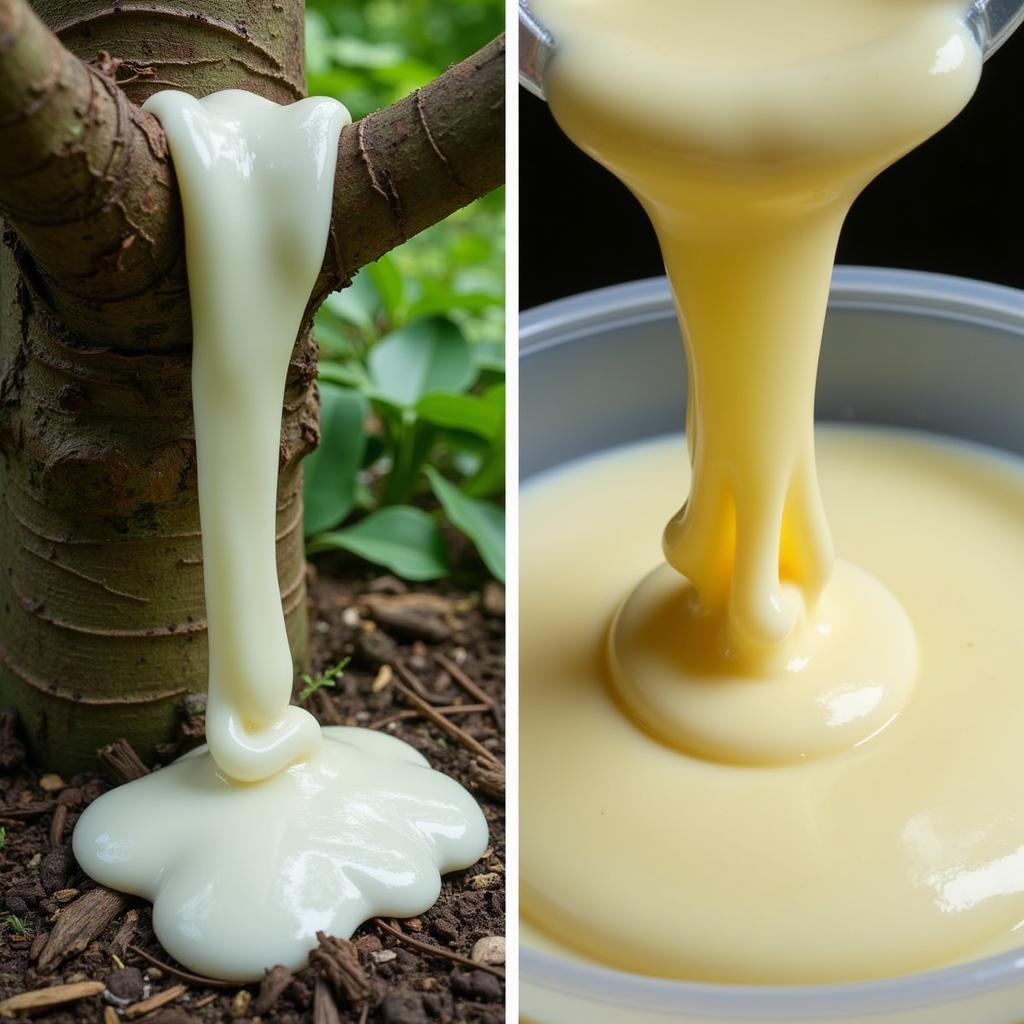Natural rubber, in its purest form, isn’t the bright white or black we often associate with rubber products. It’s actually a milky white or pale yellow color. Understanding the natural color of rubber can give you insights into its processing and the addition of colorants in various rubber goods. Let’s dive into the fascinating world of rubber and its inherent hues. Did you know you can even dye things rose gold? Learn more about How to make rose gold color icing.
Understanding the Natural Hue of Rubber
The milky white to pale yellow color of natural rubber comes from the latex sap harvested from the Hevea brasiliensis tree. This latex is a complex mixture of water, proteins, resins, and rubber particles. The color can vary slightly depending on the age of the tree, the season of harvest, and even the specific clone of the rubber tree.
Factors Affecting the Color of Natural Rubber
Several factors influence the initial color of natural rubber latex:
- Age of the Tree: Younger trees tend to produce latex that’s slightly whiter compared to older trees.
- Seasonal Variations: Latex harvested during the rainy season might be slightly more diluted and appear paler.
- Clonal Differences: Different clones of the Hevea brasiliensis tree can exhibit minor variations in latex color.
- Oxidation: Exposure to air and light can cause natural rubber to darken slightly over time, shifting towards a yellowish hue.
 Natural Rubber Latex Color
Natural Rubber Latex Color
From Latex to Finished Product: The Color Transformation
The journey from milky white latex to the various colors of rubber products involves several processing steps. These processes, along with the addition of pigments and dyes, drastically alter the final color.
Processing and Color Changes
- Coagulation: The initial step involves coagulating the latex, separating the rubber particles from the water and other components. This process can slightly alter the color, making it appear more opaque.
- Vulcanization: This crucial process, invented by Charles Goodyear, involves adding sulfur and heat to the rubber, creating cross-links between the rubber molecules. This doesn’t significantly change the color but makes the rubber more durable and elastic.
- Compounding: Various additives like carbon black, fillers, and antioxidants are added to enhance the rubber’s properties. Carbon black is commonly used to improve strength and UV resistance, resulting in the familiar black color of tires. Other pigments and dyes can be added to achieve desired colors.
You can use color in fascinating ways, even for dyeing eggs. Find out How to use food coloring to dye eggs.
Common Rubber Colors and Their Uses
- Black: The most common color, achieved by adding carbon black, offers excellent UV resistance and durability, ideal for tires and other outdoor applications.
- White: Often used in medical devices and food-grade applications, white rubber is typically achieved using titanium dioxide as a pigment.
- Brown: This color can be achieved naturally through specific processing methods or by adding specific pigments.
- Colored Rubber: A wide range of colors can be achieved using various pigments and dyes, allowing for customization in products like toys, sporting goods, and household items.
What Color is Natural Rubber in its Raw Form?
So, what color is natural rubber before any processing or additives? It’s a milky white or pale yellow, derived directly from the latex sap of the rubber tree. This natural color is often masked by the addition of pigments and dyes during processing to achieve desired colors and enhance specific properties.
Expert Insight
“The inherent color of natural rubber is often overlooked,” says Dr. Elena Ramirez, a Material Scientist specializing in rubber polymers. “Understanding this starting point helps us appreciate the complexities of rubber processing and the role of various additives in achieving the final product color.”
Conclusion
Natural rubber, in its raw form, boasts a subtle milky white or pale yellow hue. While this natural color is rarely seen in finished products due to processing and the addition of colorants, understanding its origin gives us a deeper appreciation for the versatility and adaptability of this essential material. Knowing how to color other materials like white chocolate can also be incredibly useful. Learn How can I color white chocolate. Need help with your next rubber-related project? Contact us at 0373298888 or [email protected]. Our team is available 24/7 to assist you. Our office is located at 86 Cau Giay, Hanoi.
FAQs
- Is all natural rubber white? No, it ranges from milky white to pale yellow.
- Why are tires black? Carbon black is added for UV protection and durability.
- Can natural rubber be dyed any color? Yes, with the use of appropriate pigments and dyes.
- Does the color of natural rubber affect its properties? The natural color itself doesn’t significantly impact properties, but added pigments can.
- Why is some rubber brown? This can result from specific processing methods or added pigments.
- What is vulcanization? A process that strengthens rubber by adding sulfur and heat.
- Where does natural rubber come from? The latex sap of the Hevea brasiliensis tree.
Have you considered dyeing Easter eggs with gel food coloring? Learn more about Can you use gel food coloring for easter eggs.
Curious about how color affects shedding in French Bulldogs? Explore What color french bulldog sheds the least.
If you have further questions or need specialized advice, don’t hesitate to reach out to us. We’re here to help you navigate the world of color and rubber. Contact us at 0373298888 or [email protected]. Our 24/7 customer support team is always available. Visit our office at 86 Cau Giay, Hanoi.